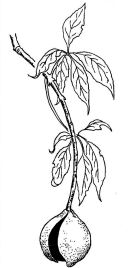by Bruce Swinehart
One of the most obvious changes that is evident in fall is the transition many plants make. To me, the drying of the grasses to a golden brown in late summer transforms the rather monotonous contours of the foothills into a colorful representation of our Golden State. As you travel through our valley, the warm brown plains create an aura of tranquility that artists consistently try to capture.
Although most of the changes in the hue of our vegetation are expected and accepted, there is one plant that makes a dramatic change that causes concern in the discerning observer.

Aesculus californica
Every year near the end of summer many people are alarmed at the buckeye tree that has all the symptoms of dying. These trees are generally seen along the streams of this area. Along our creeks there are many good examples. At this time of year we often see several trees with brown leaves that hang down as if the trees are in the throes of death. It is as if each leaf has echoed the despair of the tree in death. If one looks more closely, there are probably lemon-sized grayish-green balls hanging among the leaves. This would seem to indicate even further that something has killed the tree before the fruit has ripened. Often there are many of these trees in the same area that look the same. This is even further evidence to indicate a disease has attacked and is killing all of the trees.
Such is not the case, however. The trees are not dead or dying but merely preparing for winter. The leaves have finished making food for the tree. The leaves then die to prevent further water loss. The various mechanisms the tree has to bring this about are interesting but complicated. The fruit continues to ripen and the leaves and fruit fall later so the fruit can take advantage of the early spring rains. If the fruit is examined after the covering has split open, the rich red-brown fruit of the buckeye can be recognized.
The buckeye fruit, sometimes called the Horse Chestnut, has large amounts of tannic acid in it and as such is inedible. Beekeepers do not appreciate the buckeye as its pollen is poisonous to bees. Sometimes many bees are found dead under the tree.
Several years ago I taught a class in edible wild plants. We had successfully made edible acorn meal. I challenged the class to a project to see if they could leach the tannic acid out of the buckeye. They tried drying and roasting it and just about every other possible way. But nothing worked. No matter what was done, when water was applied to leach it, it became a gooey, mucilaginous mess. I heard it said once that if the eastern Indians had learned to make the buckeye edible, we may not have been able to colonize America. I was born in the buckeye state, Ohio, so they are special to me.
This article originally appeared in our Fall 2005 Newsletter